
Manufacturer's Specifications:
Conversion (A/D and D/A): 16-bit linear, 44.1-kHz sampling rate.
Processing Programs: 32 preset, 16 user-set.
Frequency Response: Main signal, 10 Hz to 100 kHz; processed signal, 20 Hz to 20 kHz.
Harmonic Distortion: Main signal, 0.002%: processed signal, 0.006%.
Dynamic Range: Main signal, 110 dBA; processed signal, 94 dBA.
Maximum Input and Output Levels: 3 V at 1 kHz.
Gain: ±0.5 dB.
Power Requirements: 120 V a.c., 60 Hz.
Power Consumption: 30 watts.
A.C. Outlet (Unswitched): 200 watts maximum.
Dimensions: 17 1/8 in. W x 2 13/16 in. H x 12 5/16 in. D (435 mm x 72 mm x 312 mm).
Weight: 9.9 lbs. (4.5 kg).
Price: $899.
Company Address: 6660 Orangethorpe Ave., Buena Park, Cal. 90620, USA.
With the DSP-1, Yamaha claims--and delivers--exciting and realistic modification of the stereo sound field. The model designation stands for Digital Sound Field Processor, but this only hints at what the unit actually does. Used with auxiliary amplifiers and speakers, it can make music sound as if it were in any of a dozen types of acoustic space; the acoustic parameters of each simulated space (such as room size and liveness) can also be varied somewhat. In addition, the DSP-1 can be used for surround sound, including Dolby Surround, or for musical effects. In this last mode, it can alter an input signal by adding such effects as tremolo or flanging, raising or lowering the music's pitch, and rotating the sound field in the room.
Control combinations that are frequently used can be stored in any of 16 memories. Processed signals can be recorded on tape, or processing can be applied to tape playback.
Before getting into the details of the DSP-1, I would like to discuss the live listening experience, the recording process, and listening in the home. The great majority of audiophiles are music lovers who use live performances as their reference for rating the quality of home audio systems. There is general agreement, of course, that the two experiences are different and cannot be expected to be the same.
Even the casual listener can perceive such facets as the clarity of sound in one concert hall, the dullness in another, and the garbling of detail in a third. With experience, the budding critic may have very definite feelings that a room is too live (or dead) or too small (or large) for the music that is being performed. At Tanglewood, which is part of my local scene, trios and other very small groups perform on Friday evenings as a prelude to the main concert. Because of the popularity of most of the artists involved, the preludes are presented in the main shed, which seats about 6,000 people. Even with the reflecting surface that is erected behind such small groups, the character of a smaller room is missed. At the other extreme of mismatching was a 17-piece band that I heard recently in a small and very live room. Do I have to say that even without amplification, the brass approached discomfort-producing levels? No matter where you sit in a performance venue, you will hear some combination of direct sound, early reflections, later reflections, and a continual decaying of reflected sounds (reverberation). The strength of any reflection will be determined by the angle of incidence, the spectrum of the wavefront, and the material the reflecting surface is made of. For lower frequencies, the rigidity of wall and ceiling panels also affects reflection and absorption characteristics. (Even music that is performed in a large stadium, such as a rock concert, is affected by the character of the surrounding space.) There may still be many opinions on how much the design of a good auditorium is art and how much is science, but there is no doubt that some halls are acoustically great and some are not.
When a performance is recorded, the engineer has many choices to make regarding the number, location, and type of microphones to use, not to mention the equalization he will employ. There is also the question of how the stereo character of the final two-channel master will be achieved:
Will the microphones be located and aimed so as to make it true, direct stereo? Or will the microphones be panned electronically in the mixing console to create an amplitude-related left/right sound stage? The goal, of course, is to generate a recording that will sell well, and good reproduction in the home will get favor able response from critics and buyers alike. The satisfaction of the listener can very well depend on whether there is any sensation of "being there." There can be natural or artificial reverberation in a two-channel recording, but that does not turn the home listening room into the original hall. The sound still comes from the two stereo speakers, unless the system also includes a delay unit or other such device with additional speakers and an amplifier. Even so, the sound field created in the listening room bears little resemblance to that present at the site of performance. For a sense of "being there" at a movie, Dolby Surround does provide realistic listening experiences, if the source is good. It remains generally true, however, that stereo reproduction of music in the home has remained rather pallid in comparison with the experience of being at an actual performance.
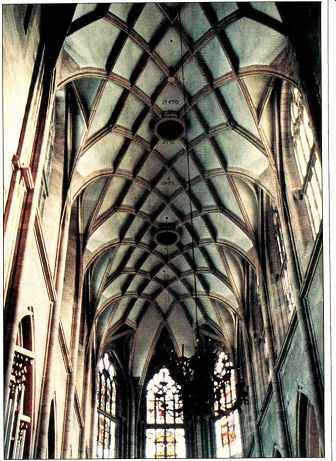
-- Interior of the Munster in Freiburg, West Germany, one
of the spaces whose acoustics were measured by Yamaha for the DSP-1.
Early reflections are very important in determining the timbre of music and thus defining a site acoustically. The subsequent reverberation is made up of many reflections that have bounced off more than one surface and overlap each other in time; this creates a diffuse sound field throughout the enclosed space. By means of four closely spaced microphones arranged to form four corners of a cube, Yamaha was able to gather and analyze data for the early reflections in many actual performance venues. The stored information told them the timing, level, and apparent source of each reflection for each location.
The DSP-1 contains stored acoustic data based on a number of different performance environments. An original Yamaha VLSI (Very Large Scale Integrated) circuit chip, operating in real time, is used to calculate dozens of discrete early reflections based upon this data. Each of the three Yamaha YM-3804 VLSI chips used in the DSP-1 incorporates a high-speed, 24-by-13-bit multiplier and a 26-bit adder and subtractor. These enable the DSP-1 to produce up to 88 discrete early reflections, 22 for each of four effect channels. Digital processing is carried out in 16-bit linear quantization at a sampling rate of 44.1 kHz.
The digitally processed delays create, in the relatively small listening room, the same time lag between the sound arrivals from the main and the effect speakers as would exist between the direct sound and the reflections from the walls in a concert hall. Thus, the boundaries of the home listening room are removed, as it were, and replaced by the characteristics of the selected performance hall.
The processor offers a great deal of operating flexibility by providing control over many of the parameters involved in the sound-field synthesis. Such things as liveness, initial time delay, and reverberation level can be varied over wide ranges for the most satisfying home listening experience.
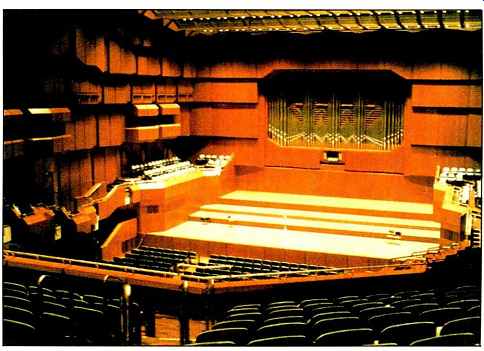
above: Part of Yamaha's measuring setup in the Alte Oper in Frankfurt West Germany.
Control Layout
The front panel of the DSP-1 gives very little indication that a great deal of sophistication is behind it. At the very left is the push-on/push-off "Power" switch. To its right are three
"Mix Input" phono jacks, labeled "Mono," "L," and "R," and a "Level" control for them. These inputs, which provide convenient front-panel access to the DSP-1's processing, can be used to mix a second signal (such as a musical instrument) with the main input source. This would be particularly helpful to a performer when using the "Sound Effector" programs, which will be discussed later. The mono input is a worthwhile inclusion because so many keyboards and other musical instruments have mono outputs. In case these inputs are used infrequently, they can be concealed by a supplied push-on rubber cover.
Farther to the right is the three-position "Tape" knob ("Effect Rec/Norm/Monitor"). The "Effect Rec" position allows the processed stereo sound to be recorded on tape. In "Monitor," the processing is applied to tape playback. To the right of the "Tape" knob is the playback level ("PB Level") pot; like the "Mix Input Level" control, it is calibrated from "0" (off) to "10," with the calibration numbers placed exactly where they'd be on a clock face. The arrangement is unusual, but it makes clear where the off position is, and it is best to keep unwanted signals at zero. All three rotary controls on the front panel have small bar-grip knobs.
The right side of the front panel is occupied by the display area. At the display's left are two red LED indicators which illuminate when the main and/or effect channels are muted.
The receptor for the supplied remote control is just below.
To the right are annunciators for the various processing modes: "Acoustic," "Surround," and "Effector" are in red, and "User Prog" is in yellow. To their right, program numbers (from 1 to 16) are shown on a red LED numeric display.
At the far right is the alphanumeric program display, in amber LEDs against a dimly lit background. The 16-character display provides essential information on the program parameters and values being used.
The need for an alphanumeric display and the lack of buttons and controls on the DSP-1's front panel make more sense when you look at the 30-button remote control. Since the DSP-1 is designed to create or alter sound fields at the listener's seat` it's only logical to make its main controls available at the listening position.
The remote control's layout provides a key to the DSP-1's operation. First, one selects a processing mode, then an effect parameter to adjust; after adjusting the parameter, one can fine-tune the system's levels. (I should point out that all the programs and parameters affect only the signals to the effect outputs and have no influence on the main stereo outputs.)
Mode selection is handled by a row of four small pushbuttons nearest the infrared transmitter end of the remote. The two inner buttons select either the "Acoustic/Surround" or "Sound Effector" modes for spatial simulation or musical effects, respectively. The "Memory" button at the left and "User Program" button at the right allow one to enter and store up to 16 user-modified program settings in memory.
(The "User Program" memories contain duplicates of the preset "Acoustic/Surround" programs when the DSP-1 leaves the factory, but modified "Sound Effector" programs can also be stored there.)
Below the four mode buttons are 16 numbered "Program" buttons, in four rows of four. Their meanings, which change with the program mode, are spelled out on the front-panel display. In "Acoustic/Surround" mode, the first dozen choices are specific types of space: "Hall 1" and "Hall 2" (a large and a medium-size hall, respectively), "Hall 3" (a multi-purpose hall seating about 1,000), "Chamber" (a grand ballroom), "Munster" (a cathedral), "Church," "Jazz Club," "Rock Cnct," "Disco," "Pavilion" (an indoor stadium), "Whse Loft" (a concrete warehouse), and "Stadium." Then comes "Presence" (separate delays to front and rear effect speakers) and three surround modes: "Sur 1" (added depth for NV sources), "Sur 2" (added width for AN sources), and Dolby Surround (indicated on the remote by Dolby's double-D symbol).
In "Sound Effector" mode, the buttons, in the same order, are: "Delay" (which varies delay independently for all four effect channels), "St Echo" (stereo echo with independently variable feedback and delay for left and right channels), "St Flange A" (echo modified by out-of-phase signals to pro duce a "varying and swirling" tone), "St Flange B" (a faster and lighter flanging effect), "Chorus A" (modulating the delay time and amplitude of different tones to produce "rolling and swaying"), "Chorus B" (slower and less pronounced chorus effect), "St Phasing" (a periodic tonal variation that shifts between right and left), "Tremolo" (a more pronounced chorus effect), "Symphonic" (also like "Chorus," but with irregular timing), "Echo Room," "Pitch Change A" (which changes the pitch of the input tone ± 1 octave, with variable echo feedback and delay), and "Pitch Change B" (similar to A, but with independent left and right settings). There are also four image-motion buttons: "L Turn," "R Turn," "F-R," and "L-R." These move the effects image continuously, at a user-variable speed, in any of six directions: Counterclockwise, clockwise, front to rear or rear to front, left to right or right to left, back and forth between left and right, or back and forth between front and rear.
The remote's program numbers (which are white on a black background) and its "Acoustic/Surround" designations (which are black on a beige background) are easy to read, but its blue "Sound Effector" labels do not stand out clearly from their black background. (Yamaha says this is intentional, to de-emphasize the "Sound Effector" mode in favor of the "Acoustic/Surround" mode, which they feel will be used 90% of the time.) The remaining 10 buttons on the remote unit have white designations, so they are easy to read. They are: "Parameter," for selecting parameters in the current program for modification; "Dec" and "Inc," for de creasing or increasing the value of the selected parameter;
"Rear" and "Front" balance controls; "Down" and "Up" level controls; " Main" and "Effect" mute keys, and "Title Edit" to generate names for user programs. This last button is used with the "Dec" and "Inc" buttons to select and place the letters, numbers, and symbols of each title on the 16-character display. The characters available include complete upper-case and lower-case alphabets (including vowels with umlauts), the 10 numerical digits, 18 math symbols and punctuation marks, and right and left arrows.
It's not impossible to list each parameter for each pro gram, but the list would be very long and complicated. So let me just summarize:
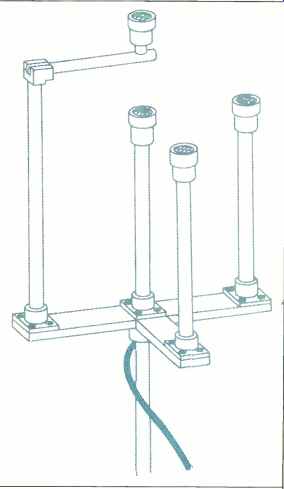
above: Microphone setup used for Yamaha's acoustical measurements.

Fig. 1--Output from the four effect channels for a 477-Hz
input in "Church" program mode. The interchannel phase and amplitude
differences will vary with input frequency and program mode.
(Horizontal scale: 0.2 mS/div.)

Fig. 2--Author's setup using the MVS-1 master volume
control with the DSP-1.
There are what amount to two hall subtypes for each of the three "Hall" programs and four subtypes ("Live," "Spacious," "Reverse," and "Dynamite!") for each of four pop/ rock venues ("Jazz Club," "Rock Cnct," "Disco," and "Stadium"). Other adjustable parameters affecting some or all of the acoustic and surround programs include: Room size, liveness (attenuation characteristics of primary reflections), the initial delay applied to first reflections, high- and low pass filters, reverberation time, relative high- and middle-frequency reverberation times, and rear reverberation level.
For Dolby Surround, only the delay time is adjustable. For "Sur 2" (which, Yamaha says, follows the Dolby Surround pattern but has additional enhancements), one can adjust liveness, room size, initial delay, and filter settings; in addition, different hall subtypes can be selected. The "Sur 1" mode has similar parameter choices but apparently does not follow Dolby Surround. For "Presence," there is independent delay selection for each of the four effect channels, plus high- and low-pass filter control.
For the "Sound Effector" programs, parameters that can be adjusted include delay time, high- and low-pass filter settings, amount of echo feedback, modulation frequency and depth (for variable-rate programs such as flanging, phasing, chorus, and tremolo), reverberation time, pitch (coarse and fine), and panning speed and direction.
The rear panel of the DSP-1 has 14 phono jacks. Twelve are stereo pairs: Input, main, and processing (front and rear) outputs, and record and playback connections for a tape recorder. The other two jacks provide mono outputs for a center-position speaker ("Full Band") and a subwoofer (" Low Pass, fc 200 Hz"). Also on the rear panel are an input-balance pot with a center decent (primarily for Dolby Sur round) and two slide switches. The "Front Mix" slide switch is set for six-channel or four-channel operation to match the amplifier and loudspeaker configuration used. The normal combination is conventional stereo plus front and rear dual-channel processed sound. If just the rear speakers are used for the processed sound, putting the slide switch to "4ch/ On" adds the processed front sound to that going to the main stereo speakers. The other slide switch reduces the main output by 10 dB, if needed, to get a better level match between the main and the effect speakers. The final item on the rear panel is an unswitched a.c. outlet rated at a maxi mum of 200 watts.
Removing the top and side cover of the DSP-1 revealed three large p.c. boards. One was a little more than one-half chassis size; the others were a bit smaller and stacked one above the other. The boards and the components were of high quality, and the soldering was excellent. Interconnections were made with multi-conductor cabling. Fixed resistors and capacitors were not identified, but other components were, and function areas were labeled. All ICs were soldered in, including the three impressively large VLSI YM 3804s. There was little springiness to the boards, and the chassis support was quite rigid. No fuses were noted, al though one or two of the power-supply resistors might serve that function.
Measurements
All of the test results reported here were actually obtained at the conclusion of the use and listening tests. I did not attempt to measure all of the electronic characteristics, but I did check the DSP-1 against Yamaha's specifications to verify some of the parameters and to find out what the resolution was for all of the parameter steps.
The maximum input voltage varied a great deal, being very dependent upon the program and the exact frequency of the test tone. The specified 3 V is a good figure for the great majority of circumstances. The worst case was an input limit of about 0.9 V, which occurred only in the front channels, and then under very restricted circumstances (only in the "Church" program, and only with a steady tone between 504.9 and 505.2 Hz).
Figure 1 shows the output from the four effect channels at 477 Hz in "Church." The oscilloscope was locked to the front left signal. The front right signal lags by 90° and is the lowest in amplitude. The rear right signal lags by the same amount but is higher in amplitude. The rear left output lags more and has the highest amplitude. Small changes in frequency caused large changes in the amplitudes and their relationships, as did changes in program at the same frequency. The characteristics of the processed sound are very complex and not easily stated or measured.
I measured signal-to-noise ratios of 103.7 dBA for the main outputs and
86 dBA on the average for the effect outputs, both referred to 1 V. Distortion
was 0.0018% for the main outputs and 0.0055% for the effect outputs. The
main outputs were down just 0.4 dB at 20 Hz and 0.8 dB at 20 kHz. The effect
outputs were down the same amount at 20 Hz and down 2.7 dB at 20 kHz. (In
Dolby Surround, the required high-frequency roll-off occurred.) There was
a small level change in the signal through the main channels: -0.4 dB for
the left and-0.5 dB for the right.
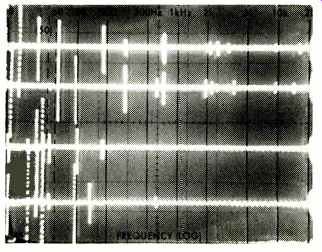
Fig. 3--Output from the four effect channels for a 977-Hz, single-cycle
tone burst fed to both input channels in "Hall 3" program mode.
Traces are (top to bottom): Left front, right front, left rear, and right
rear. (Horizontal scale: 50 mS div.)

Fig. 4--Setup without MVS-1 showing all channels in use, with master volume
controlled by the system preamp and effect-channel levels and balance controlled
by the DSP-1. Using an amplifier with volume control for the center and
subwoofer channels would simplify balancing.
For easy adjustment of all six channels simultaneously, I used the accessory MVS-1 level control--a $149 option with my system configured as shown in Fig. 2. (If your system allows the DSP-1 to be connected between your preamp and main power amplifier, this option is not absolutely necessary.) With the MVS-1 connected to the DSP-1's outputs, the overall level drop from the DSP-1's input to the MVS-1's output was 1.6 dB for the left and 1.7 dB for the right. I judged this to be acceptable, considering the benefits of using the MVS-1.
Input impedances were 51 and 31 kilohms for the DSP-1 and MVS-1, respectively. The DSP-1's output impedance was 1.4 kilohms; that for the MVS-1 was 1.7 kilohms at maximum setting, with an increase to 2.9 kilohms at the 3 o'clock position. All six sections of the control tracked each other within 1 dB from maximum output down to 75-dB attenuation-absolutely sterling performance.
Figure 3 shows the four effect-channel outputs for a 977-Hz single-cycle burst with the DSP-1 set to its "Hall 3" program. There are some similarities between the front-channel outputs and between the rear-channel outputs, but all four outputs are different with respect to their initial reflections. Without any external signal fed in, there was leakage of 44.1 kHz at -112 dB (re: 1 V); there was also a 31.1-kHz tone at - 92 dBV, with lower-level sidebands 250 Hz above and below this frequency.
I measured the range and step-size (resolution and number) for all parameters but did not perform listening evaluations for them all (particularly those for the "Sound Effector" programs). My check of the parameters and the possible steps showed the following: "Room Size" could be set anywhere in an 80-step range; "Liveness" had a 10-step range; "Initial Delay" could be set from 5 to 150 mS in 1-mS steps; the high-pass filter could be set in what amounted to 32 one-sixth-octave steps from 32 Hz to 1.0 kHz, plus flat, and the low-pass filter could be set in 26 one-sixth-octave steps from 1.0 to 16 kHz, plus flat. "Reverberation Time" allowed settings from 0.3 to 5.0 S in 0.1-S steps, from 5.5 to 10 S in 0.5-S steps, from 11 to 20 Sin 1-S steps, and from 25 to 95 S in 5-S steps, plus a final step to 99 S. "Reverberation Time Ratio" (high-frequency reverberation decay relative to mid-frequency reverberation time) could be set from 0.1 to 1.0 in steps of 0.1, and "Presence Delay" from 0.1 to 600 mS in 0.1-mS steps.
For "Sound Effector" programs, parameters included:
"Stereo Echo Delay" from 0.1 to 270 mS in 0.1-mS steps; "Feedback Gain," ±95% in 1% steps; "Modulation Frequency" from 0.1 to 20.0 Hz in 0.1-Hz steps; "Modulation Depth" from 0 to 100% in 1% steps; "Modulation Delay" from 0.1 to 100 mS in 0.1-mS steps; "Delay Time Modulation Depth" from 0 to 100% in 1% steps; "Amplitude Modulation Depth" from 0 to 100% in 1% steps; "Echo Room Delay" from 40 to 270 mS in 10-mS steps, and "Pan Speed" from 0.1 Hz to 20.0 Hz in 0.1-Hz steps. Also "Pitch Change" (coarse), ±12 semitones in 1-semitone steps; "Pitch Change Fine," ± 100 cents in 1-cent steps (1 cent = 0.01 semitone); "Effect Level" from 0 to 100% in 1% steps, with a bar illuminated for each 10%, and front-to-rear "Effect Balance" from 0 to 100% in 1% steps. (The "Effect Balance" display shows the front-rear ratio graphically, on a 10-bar scale, and numerically.) A couple of other delays and one gain parameter, not listed here, had the same steps as the delay and gain settings detailed above.
I find the resolution provided for all of these parameters to be more than impressive but less than overwhelming. For all parameters in each of the programs, there are default set tings which can be changed as often or as infrequently as desired. I did check the accuracy of the pitch changes, and all of the steps were within 0.2% or better. Using the fine adjustment, I trimmed a 1-octave shift (+12 coarse) to be within 0.015%. It was very easy to run all of the above tests using the remote control for program/parameter changes and reading the selected functions on the excellent panel display. Holding in the "Inc" or "Dec" buttons produced speedy value changes.
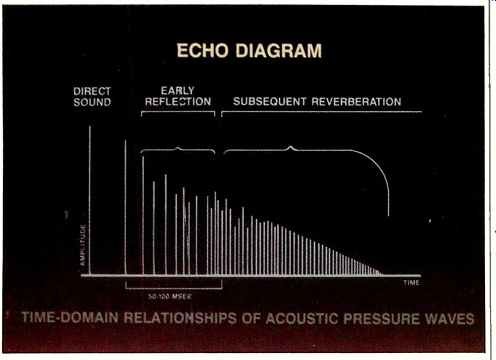
Early reflections, which arrive 50 t 100 mS after the
direct sound, help determine the timbre of music and define a site acoustically.
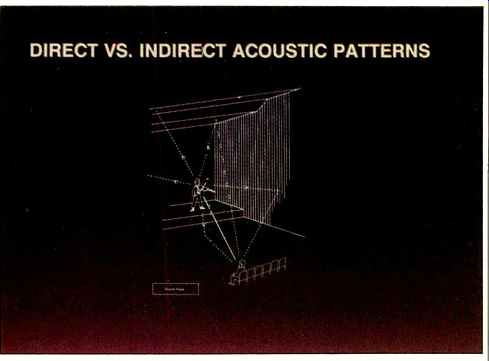
The DSP-1 is designed to simulate the direction, volume,
and timing of early reflections in the concert hall.
Setting Up
I started off with a four-channel configuration, mixing the processed front sound with the regular stereo signal. I tried various combinations of amplifiers and loudspeakers, and the preliminary results were impressive.
However, I tempered my eagerness to hear what the DSP-1 would do, taking the time to get all equipment installed as shown in Fig. 2. The Yamaha MVS-1 master volume control served as the input selector for the system. (The DSP-1 can be used without the MVS-1, however; see the sample hookup illustrated in Fig. 4.)
Sources included a Pioneer PD-9010X CD player, an Onkyo TX-2500 receiver for FM broadcasts, an Akai VS-555U VHS VCR for stereo TV broadcasts, and a Yamaha LV-X1 Digital videodisc player. Tape recorder and turntable outputs were fed through the receiver.
The main stereo loudspeakers were JBL 4301 Bs driven by an AB Systems 205 amplifier, the four effect speakers were Dynaco A25s powered by Yamaha's M-35 four-channel amplifier, and the center speaker was a JBL 216 driven by a Lafayette amplifier. A self-powered Triad subwoofer was connected in parallel with the 4301 Bs.
Because all of the speakers were placed high on the walls, there was an unwanted reinforcement of bass energy.
A Soundcraftsmen DC2214 dual-channel octave-band equalizer was inserted between the MVS-1 and the input of the DSP-1. I adjusted the equalization to find what I considered the best compromise between flattening overall response and maintaining the impact of relatively low-frequency attacks. After running a number of preliminary checks, I decided that I had better control of main and effect levels if I used the level switch on the DSP-1's rear panel to reduce the main output by 10 dB. An oscilloscope monitor was connected to the left and right outputs of the MVS-1 to check all sources for stereo content.
Use and Listening Tests
The 40-page manual that I used during the evaluation has much detail in it. The illustrations are good, and there are well-written explanations. It's hard to fault the manual, but I'm certain that many users would benefit from more discussion on speaker selection and placement, possibilities and limitations with equalization, and the relationships between parameter values and their perceived character. Other sup plied literature helped me to understand how the unit was developed and how its data base was secured.
Everything was completely reliable throughout my evaluation, and for all its internal complexity, the DSP-1 never left me confused about what I had done. I did find that I could not read the program/parameter/value display from more than 10 feet away, but that was frustrating only at the beginning. I did have to step closer at times to verify what was happening, but most often I was making adjustments for the best sonic results, using my ears as the reference. At those times, the fact that I didn't know the exact reverberation time, for example, was completely unimportant. The remote control was effective over a very wide angle-up to 60° off axis-and up to 25 feet away. I would have liked remote control of overall level, but I was glad to have both main and effect muting as well as remote control of effect balance and level.
The DSP-1's great appeal is how easily it can change the apparent character of the "performing hall" to match any personal preference. When I first started listening, I tried all the "Acoustic/Surround" programs; with experience, I learned that some programs would be bad choices for particular types of music. I also tried modifying some of the parameters; I'll say more about that when I get to specific examples. Most listening was done with CDs as sources, but I did try several other sources and I'll discuss them first.
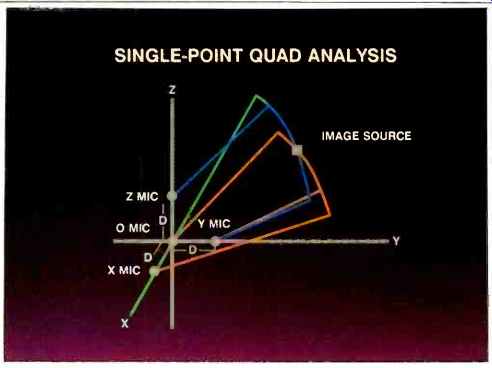
To measure listening-space acoustics, Yamaha used four microphones
arranged to form four corners of a cube.
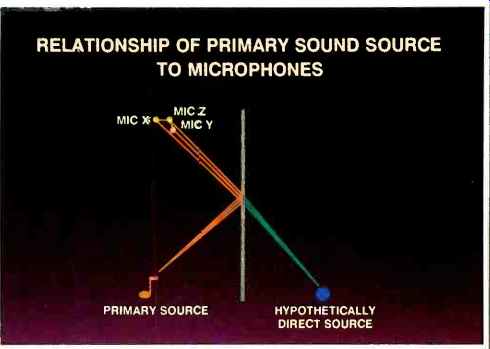
How three microphones can identify a sound's source, in a reflective
space, as being at either of two points. Adding the fourth microphone allows
the one correct point to be identified.
Stereo TV
There aren't many stations broadcasting stereo TV yet.
Though my local cable system passes stereo signals, only one-quarter of its channels are in stereo. The cable company uses simulcast FM for stereo sound from MTV, Showtime, and HBO, but transmits broadcast signals with MTS stereo.
Of the major-network broadcasters, the NBC stations provided the best signals, but one of the nearby PBS stations, WMHT in the Albany, N.Y area, delivered stereo that was superior to the other channels in all respects.
Because of the prevalence of dialog in the TV offerings, most of the DSP-1's acoustic programs could not be used an actor in the center of the screen did not sound right with reflections and reverberation. The "Presence" program did sound very acceptable a number of times, however. The most appropriate program choice was usually "Sur 1," "Sur 2," or Dolby Surround. The center speaker was generally helpful, but no TV program benefited from the subwoofer.
With some music programs, it was worthwhile to switch to an appropriate acoustic program, accepting the odd effects on speech or muting the effect channels when there was speech only.
With the simulcast sources, which delivered low signal strength to my receiver, noise was noticeable in the surround programs, and "Presence" was the preferred choice.
A broadcast of the movie F/X appeared to have limited stereo content, but there were definite and worthwhile improvements when I used the DSP-1. The limitations of most current stereo N sources were obvious much of the time, but the spread and depth added by the DSP-1 were desirable enhancements anyway.
Videocassettes and Videodiscs
A number of videocassettes with Dolby Surround encoding were tried. The results were always far superior to simple stereo. Karl-Lorimar Home Video's Maximum Over drive had really good surround sound throughout. I found the best choice a toss-up between "Sur 2" and Dolby Surround, with "Sur 1" and "Presence" pleasurable but less satisfactory.
In some ways, it was easier to make extra-critical judgments with videodiscs than with videocassettes, because the quality of the discs was obviously superior. "Presence" and the three surround programs remained the most acceptable choices; of these, "Sur 2" or Dolby Surround was always the first choice of all listener/viewers whose comments I solicited. The center speaker was helpful even when its effect was on the subtle side.
FM Stereo
There was no doubt about the great improvement the DSP-1 made in the overall FM stereo listening experience.
Muting the effect channels (which collapses the sound field to a simple frontal stereo image) showed regular stereo, by comparison, to be a poor thing indeed.
While listening to music stations, I kept changing my mind on what was best: If I considered just the music, the DSP-1 had many acoustic programs to choose from, but if I wanted the announcements to sound somewhat normal, I had to stick to a surround mode or use "Presence." Sometimes I found that "Hall 3" with reduced initial delay was a good choice. Programs I selected quite regularly to match the music were "Hall 1," "Hall 2," "Hall 3," "Chamber," "Church," "Pavilion," "Whse Loft," "Stadium," and "Presence." You may find it hard to believe that some of these would be any good at all, but they were. I reduced initial delays and reverberation times for "Chamber" and "Church" and stored these modified programs in user memory. They proved to be the best choices a number of times.
The center-channel speaker was best kept off when playing music, even if the announcements seemed better with it turned up at least to a low level. The subwoofer was of value a limited number of times.

Another Yamaha research setup, here measuring the acoustics
of the Beethoven Saal in the Liederhalle in Stuttgart. West Germany.
I tried various combinations of main and effect levels, and various types of balance between front and rear effect levels. I usually preferred the effect level higher than the main level and found that equal front and rear effect levels sounded good. A check with a sound-level meter showed that my usual preference was for the main level to be about 6 dB below the effect level, measured at the listening position. The range of the difference was from 3 to 10 dB, with the main level never set as high as the effect level.
LP Records
Many program selections were possible for LPs, with the best choice depending, of course, on the type of music.
Here's one example of the choices I made: Ravel and Chausson piano trios with the Beaux Arts Trio (Philips 411 141-1) sounded best with my user-program version of "Chamber." I also liked "Hall 3" (with the "On Stage" type of primary reflection), "Hall 1" (with "Type B" reflections), and "Hall 2" (with "Type D" reflections). I expect that others would make different choices.
The one negative element that I noticed with LPs was that ticks from scratches became particularly distracting when coming from so many speakers and with the delays from the DSP-1's processing. I'm sure, however, that I would continue listening to records through the DSP-1, since my own LPs have very infrequent clicks. In any event, the overall enhancement of the sound makes those clicks seem of relatively minor importance.
Audio Tapes
I did not try a large number of tapes, but all of them were ones that I had recorded myself. Thus, I was very certain of the acoustical character of each of the original performing sites. I also knew, of course, what arrangement I had used for the recording microphones.
One of the tapes that I spent a fair amount of time with was of Handel's "Messiah." The church in which it had been recorded is not large; because a portion of the ceiling has acoustical tile, it is not as live as its other surfaces would indicate. The "Church" program was too reverberant, even in my user-program version. My modified version of "Chamber" was the best, with "Hall 3 (On Stage)," "Hall 2 (D)," and "Hall 1 (A)" the next best choices, in that order.
Another tape was made at a larger church, one that has a stone and wood interior with a high nave. Franck's "Fantaisie in A Major" for organ and Fauré's "Requiem" were the major works. This was one of the very few recordings of any type (LP, tape, CD) that sounded good with the " Munster" program, and that program was a close match, in general, to the church's characteristics. In the "Requiem," I did prefer the results when I reduced the reverberation time from 4.0 to 3.2 S, the initial delay from 95 to 75 mS, and the reverberation level from 100% to 90%. These may not seem to be major changes, but they made a definite improvement as far as I was concerned. What is described here points out the broad capability of the DSP-1 to deliver many different possible acoustical environments and then to allow fine tuning for maximum listening pleasure.
While listening to the tape playback, I was puzzled by one effect that I heard from the applause at the end of the performance. During the music, the sound from all the speakers blended well, but I heard what seemed to be separate sounds of applause from the main and effect speakers. Checks with an RTA showed that the spectra were the same, although they didn't sound that way. When I matched the main and effect levels, there was smooth blending of the applause. My conclusion was that the higher level of the applause from the effect speakers produced a flatter perceived response than that for the lower level main speakers. I relegate this oddity to the class of the very unimportant, for I rarely spend time listening to applause.
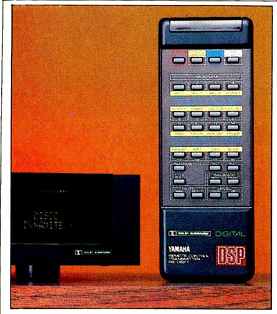
Functions of the numbered "Program" keys depend
on the mode being used.
Compact Discs
A total of 23 CDs were used in assessing the performance of the Yamaha processor. I listened to them in groups according to music type, and, within each group, in chronological order of the music's composition. Mozart's 39th and 40th Symphonies (Bamberg Symphony Orchestra led by Eugen Jochum, Orfeo C 045 901A) and Tchaikovsky's Fourth Symphony (Cleveland Orchestra, Lorin Maazel, Telarc CD-80047) made up the first group. For this music, all three "Hall" programs and "Chamber" were good choices overall, but the best choices for specific pieces were: "Hall 3 (Live)" for Mozart's 39th, "Hall 1 (A)" for Mozart's 40th, and "Hall 1 (B)" for Tchaikovsky's Fourth.
For Vivaldi's "The Four Seasons" (Boston Symphony Orchestra, Seiji Ozawa, Telarc CD-80070) and Mozart's "Eine Kleine Nachtmusik" (Prague Chamber Orchestra, Charles Mackerras, Telarc CD-80108) I did prefer the "Chamber" program, although with the Mozart a reduction in reverberation time seemed in order.
There was general agreement as to the appropriate set tings for Tchaikovsky's "1812 Overture" (Cincinnati Sym phony Orchestra, Erich Kunzel, Telarc CD-80041), Debussy's "La Mer" (Saint Louis Symphony Orchestra, L. Slatkin, Telarc CD-80071), and Stravinsky's "Firebird Suite" (Atlanta Symphony Orchestra, Robert Shaw, Telarc CD-80039). The "Hall" modes were the favorites for these works, with "Hall 3 (Live)" the best for the Tchaikovsky and the Stravinsky, and "Hall 1 (B)" the choice for the Debussy.
Another group consisted of orchestral music by Wagner, Waldteufel, Rossini, Elgar, and others, plus a collection of movie music, Star Tracks ( Cincinnati. Pops, Erich Kunzel, Telarc CD-80094). All listeners preferred the "Hall" pro grams, with "Hall 1 (B)," "Hall 2 (C)," "Hall 2 (D)," and "Hall 3 (Live)" the most popular. For organ works, " Munster" was not the first choice most of the time. Bach: The Organs at First Congregational Church, Los Angeles with Michael Mur ray (Telarc CD-80088) was better with "Church." Saint Saens' Third Symphony (Philadelphia Orchestra with Michael Murray, led by Eugene Ormandy, Telarc CD-80051) was very good with "Church," but I had a slight preference for my user-modified version of "Church," with its shorter reverberation time.
I tried comparisons between settings for a CD of Charpentier motets with the Concerto Vocale (Harmonia Mundi HMC 901149) and for Simon Estes singing spirituals with the Howard Roberts Chorale (Philips 412 631-2). My user-modified version of "Chamber," with its shorter reverberation time, was my favorite for both discs, but my second and third program choices were not the same for the two CDs.
Bachbusters by Don Dorsey (Telarc CD-80123) sounded best with "Presence," "Rock Cnct," "Jazz Club," or my user-modified "Chamber," but my first choice changed from track to track. Let's Dance, Vol. 8, with the Columbia Ball room Orchestra (Denon C32-7897) had the same collection of choices, but user-modified "Chamber" was preferred.
Peaches and Cream: Music of Sousa (Cincinnati Pops, Erich Kunzel, Vox Cum Laude MMG MCD 10005) was poor with "Munster," "Church," "Disco," and the surround pro grams, but it sounded good with substantially everything else, including "Whse Loft," "Pavilion," and "Stadium." I could almost visualize the band playing in any of the "spaces" created by the DSP-1.
Popular music was represented by Creedence Clearwater Revival's Chronicle (Fantasy FCD 623-CCR2), Dire Straits' Brothers in Arms (Warner 25264-2), Emmylou Harris' The Ballad of Sally Rose (Warner 25205-2), and Synchronicity by The Police (A&M CD-3735). "Jazz Club" and "Rock Cnct" were the first and second choices, respectively, for all except the Harris CD, for which the order of choice was reversed. "Disco" and "Presence" were also likable, al though the "Disco" bass was too heavy on some tracks.
Notice that for these CDs the program choices are not the same as those made for classical music, and that the best choices are those that might be expected from the names of the programs. This is further evidence that Yamaha did its homework to deliver a collection of acoustical/surround choices to satisfy all types of music.
The "Sound Effector" I had the chance to discuss the characteristics of the "Sound Effector" programs with people who are more knowledgeable than I on what they might do in specific situations-with a keyboard, for example. Their response was enthusiastic, but I thought I should give myself an actual demonstration. I decided to use Bachbusters, which is primarily keyboard. Well, I had a ball! I tried all of the "Sound Effector" programs, and most of them created something that was both interesting and enjoyable. I found that the Presto from the "Italian Concerto" was particularly amenable to being delayed, flanged, modulated, phased, and panned around the room in all directions. These manipulations were not pleasurable with any of the other music I tried, but it was great fun while it lasted.
Conclusions In presenting so much detail on what I did (and what can be done) with the DSP-1, I certainly hope I don't convey the impression that the user must be pushing buttons continually to listen to music. Any of the controls can be operated as little or as much as desired. Even if the DSP-1 is used without the modification of any parameters, there are many useful choices to make from the acoustic and surround programs. If changes are made, they are easily stored and recalled to ensure maximum listening pleasure.
The Yamaha DSP-1 stands as a unique device in its ability to create the illusion of hearing music in many different performing venues. It is far superior to many previous de vices that have attempted to accomplish similar things. If the goal is to simulate "being there," the DSP-1 has achieved more over normal stereo reproduction than any thing else, including the introduction of the CD. Muting its effect channels causes an emphatic collapse to the frontal stereo sound stage, with a tremendous loss in realism. I have noticed too that with the DSP-1, the sound in adjoining rooms is also far better-as though the orchestra really were in the next room.
The Yamaha DSP-1 is not an inexpensive device, but with an inexpensive amplifier and two even moderately priced rear effect speakers, it can deliver more easily observable improvements for its cost than any other component. Front effect speakers can be added as the budget permits, allowing further enhancement in the acoustic/surround sound fields.
-Howard A. Roberson
[based on review from Audio magazine, Jun. 1987]
Also see:
YAMAHA DSP-A2070 Digital Sound-Field Processing Amplifier (Sept. 1993)
Philips Key Modules IS 5021 Digital Signal Processor (Aug. 1996)
============